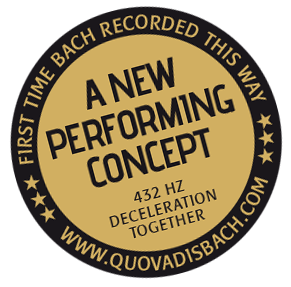QuoVadisBach
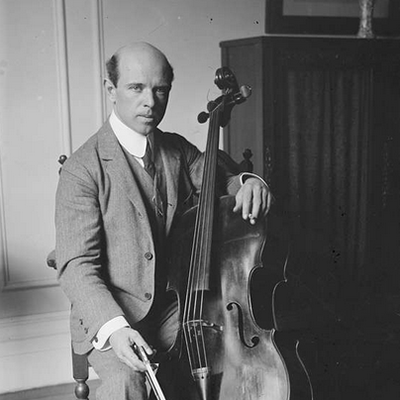
DE – Pablo Casals war der unvergessliche Maestro, der die Suiten für Violoncello ans Licht brachte und mit wundervoller Perfektion ein für alle Mal die Grenzen der Aufführungspraxis festlegte, die jahrzehntelang niemand zu überschreiten wagte. Über die Jahre hinweg wurden hunderte Aufnahmen eingespielt, große Cello-Meister und Virtuosen haben auf einzigartige Weise die Fackel weitergegeben und den von Casals beschrittenen Weg perfektioniert und ergänzt. Welchen Sinn hat es also, eine weitere Aufnahme hinzuzufügen, noch dazu von einem unbekannten Cellisten, der bescheiden auf die großen Meister der Vergangenheit zurückblickt?
Der Sinn könnte sich beim Hören dieser CD erschließen, wenn Sie alles vergessen, was Sie bisher über Bach gehört haben (ganz abgesehen davon, dass es sicher eine der wenigen Aufnahmen ist, die mit 432Hz eingespielt wurden). Wer den Versuch unternimmt, die Suiten mit einer Person, die ausgestreckt vor ihm auf dem Boden liegt und die er über seine Musik bei der Meditation und Einkehr begleiten möchte, zu spielen, der wird feststellen, dass er gezwungen ist, die Ecken und Kanten des eigenen Ego abzumildern – gerade so, wie ein Bach (der Name spricht für sich) die Steine abschleift und abrundet, bis sie schließlich zu Sandkörnern werden. Gedämpftes Spiel, das bedeutet nicht so sehr leise, als vielmehr auf Zehenspitzen zu spielen, sich respektvoll und aufmerksam auf jenen Atemzug desjenigen einzustellen, der vor dir liegt.
QuoVadisBach?
Wir wissen nicht wohin, aber die Spur führt im Frühsommer des Jahres 2016 zur ehemaligen Steinmühle in Oberösterreich, neben der der vertraute Bach rauscht. Der Blaue Saal ist großzügig, fast ein Kubus, das zauberhafte Licht schafft eine magische Atmosphäre, die noch verstärkt wird von den musiktherapeutischen und künstlerischen Instrumenten Katharina Flückigers.
Während der gesamten Aufnahmen haben 12 Personen abwechselnd vor dem Violoncello liegend Platz genommen. Ich habe mir vorgestellt, dass ich sie mit meinen Tönen sanft wiege und ihre Herzen umschmeichle, um zu erreichen, dass ihre Gedanken sich von den dahinfließenden Noten forttragen lassen. An den Wänden im Halbdunkel saßen die Personen, die darauf warteten, ihren Platz vor dem Cello einzunehmen oder die bereits davor gelegen hatten.
Die Entscheidung, die Suiten auf diese Art zu spielen, ist ein bewusster und mutiger Bruch – die musikalische Geste verliert sich und gibt an ihrem Grenzbereich der Meditation Raum, dem Versuch, Bach zu entmathematisieren, der mathematischen Perfektion den mechanischen Aspekt zu nehmen. Das Metronom wird verbannt, um den Schimmer neuen Lichts zwischen den Ritzen der Noten zu erforschen. Eine musikalische Überfahrt, bei der der Bach zwischen den Mauern der ehemaligen Mühle, die unter den großzügigen Händen von Peter Wahl neu erstanden ist, zu einem Ozean anschwillt. Trotz des tosenden Bachs, gibt es viel Stille. In diesem Raum, in dem früher Korn gemahlen wurde, um den leiblichen Hunger zu stillen, werden nun Schwingungen gemahlen, um der Seele Nahrung zu geben…
Der Pulsschlag des Herzens und der Rhythmus meiner Atemzüge treten in Resonanz zu denen meines Reisegefährten, der vor mir ausgestreckt liegt, und werden eingewoben in das Manuskript von Anna Magdalena. Gerade dieses unschätzbare Schriftstück erschließt mir durch die Angabe der Bögen (die von vielen als unzusammenhängend und unzureichend empfunden werden) eine neue und überwältigende Schönheit. Es ist dies eine zeitlose Schönheit, fern aller Technik und alles Mechanischen. Für uns, die wir daran gewöhnt sind, alles zu ordnen und zu vereinheitlichen, stillt sie ein tiefes Bedürfnis und das Manuskript von Anna Magdalena ist wie ein Geschenk von unschätzbarem Wert, wenn man sich die Mühe macht, sich darin zu versenken. Inspiriert von Albert Schweitzers Ermahnung, ist es unerlässlich, das notierte Zeichen für den Zuhörer nicht zum Chaos werden zu lassen. Daher ist es notwendig, Bachs Musik nicht in Zeitlupe, sondern vielmehr entschleunigt zu spielen.
Musik und Stille verschwimmen im goldenen Licht des Blauen Saals und umfangen mich mit einem Gefühl der Verbrüderung, die mich mit dem Leben eint. Mit Freude erlebe ich die kontemplative Ruhe, die durch die Entschleunigung in mir entsteht. Es ist ein erster Schritt, um die Kraft der Langsamkeit zu erlernen, es ist die Begegnung mit einer neu erstandenen Freiheit.
Davide Zavatti
(Translated by Eva Sturm)
IT – Pablo Casals fu il maestro indimenticabile che portò alla luce le Suites per violoncello, definendo in maniera meravigliosamente perfetta e memorabilmente irrevocabile i limiti di prassi esecutiva che per decenni nessuno ha osato oltrepassare. Centinaia di incisioni si sono accumulate negli anni, maestri e virtuosi del violoncello si sono avvicendati in una staffetta ideale per migliorare e ampliare il sentiero tracciato da Casals. Che senso ha allora aggiungerne una ulteriore, fra l‘altro eseguita da un violoncellista sconosciuto e che con umiltà guarda i maestri che l‘hanno preceduto?
Il senso lo potreste trovare nell‘ascoltare questo CD dimendicando tutto quello che avete finora ascoltato di Bach (al di là del fatto che è sicuramente una delle poche registrate a 432Hz). Chiunque provi a suonare le Suites con una persona distesa di fronte e con l‘intento di accompagnarla attraverso la musica nella meditazione e nel raccoglimento sarà costretto, suonando, a smussare gli spigoli del proprio ego, esattamente come il ruscello (in tedesco Bach!) leviga le pietre fino a farle diventare tonde, e alla fine sabbia. Suonare sottovoce, che non significa solo suonare piano, ma in punta di piedi, con rispetto e ascoltando il respiro di chi ti sta di fronte.
QuoVadisBach?
Non lo sappiamo, però è in cammino. È passato a inizio estate 2016 dalla Steinmühle in Alta Austria, un ex mulino a pietra dove a fianco scorre un ruscello (Bach). La Blaue Saal é una sala magnifica, quasi cubica, luce meravigliosa e atmosfera magica. Piena di strumenti per la musicoterapia e l‘arte musicale di Katharina Flückiger.
Durante tutta la registrazione si sono alternate 12 persone che si sono sdraiate davanti al violoncello. Ho immaginato di cullarle con il suono, cercando che posassero la loro mente sul fluire lento delle note, accarezzandone il cuore. Ai margini della sala, in penombra, stava seduto chi aspettava il proprio turno per sdraiarsi o lo aveva già fatto.
La scelta di eseguire le Suites in questo modo é uno strappo consapevole e coraggioso, mentre il gesto musicale sparisce per lasciare posto a meditazioni di frontiera, tentativo di dematematizzare Bach, di togliere l‘aspetto meccanico alla perfezione della matematica, con il metronomo in esilio, per esplorare spiragli nuovi fra le fessure delle note. Una traversata musicale, nel ruscello (Bach) che diventa un oceano fra i muri una volta mulino, ricostruiti grazie alle mani generose di Peter Wahl. C‘è molto silenzio nonostante il fragore esterno dell‘acqua del ruscello (Bach). In quella sala in cui prima si macinava il grano per sfamare i corpi fisici adesso si macina vibrazione per nutrire le nostre anime.
Il pulsare del cuore e il ritmo del mio respiro entrano in risonanza con il compagno di viaggio che è sdraiato davanti a me, e si intrecciano con la scrittura del manoscritto di Anna Magdalena. Ed è proprio questo prezioso documento che attraverso le indicazioni delle arcate (da tanti ritenute incoerenti e insufficienti) in realtà mi svela una nuova e meravigliosa grande bellezza. Una bellezza fuori dal tempo, estranea alla tecnica e alla meccanicità. Di questo abbiamo assolutamente bisogno, abituati a sistematizzare e omologare tutto, e il manoscritto di Anna Magdalena è un regalo di inestimabile valore se ci si impegna a leggerlo nel profondo. E allora, ispirandomi ad Albert Schweitzer, affinché il segno grafico non diventi caos per l‘ascoltatore è vitale suonare non al rallentatore, ma lentamente.
Musica e silenzio si mescolano nella luce dorata della Blaue Saal in un abbraccio con il sentimento di fratellanza che mi unisce alla vita. Gioisco della calma contemplativa che la decelerazione mi offre. È un primo passo per imparare la forza della lentezza, è l‘incontro con una rinata libertá.
Davide Zavatti
EN – Pablo Casals was the unforgettable master who discovered the Suites for violoncello, defining the limits of performance practice in a wonderfully perfect and memorably irrevocable way, which for decades no one has dared to cross. Hundreds of recordings have been made over the years, masters and virtuosos of the violoncello have come and gone in an ideal relay race to improve and widen the path blazed by Casals. What is the point then of adding yet another recording, moreover performed by an unknown cellist who humbly looks up to the masters who preceded him?
You might find the sense by listening to this CD, forgetting all that you have heard up to now of Bach (beyond the fact that it is definitely one of the few recorded at 432Hz). Anyone who tries to play the Suites with a person lying in front of them, and with the intent to accompany him/her in meditation and recollection through music will be forced, while playing, to smooth the rough edges of his ego, just as a stream (Bach in German!) smoothes stones until they become round, and finally sand. Playing softly does not mean playing quietly, but on tiptoe, with respect and while listening to the breath of the person in front of you.
QuoVadisBach?
We don‘t know, however, it‘s on the way. It probably passed by Steinmühle in Upper Austria in early summer 2016, a former stone mill with a stream (Bach) flowing alongside it. The Blaue Saal is a magnificent room, almost cubical, with wonderful light and a magical atmosphere. It is full of instruments for Katharina Flückiger‘s music therapy and musical art.
Throughout the recording, 12 people took turns lying down in front of the violoncello. I imagined cradling them with sound, trying to put their mind on the slow flow of the notes, caressing the heart. Around the borders of the room, in the shadows, those waiting for their turn to lie down or those who had already had their turn were seated.
The decision to perform the Suites in this way is a conscious and courageous approach, while the musical gesture disappears and a path to deep meditation opens up; it is an attempt to demathematize Bach, to take the mechanical aspect away from the mathematical perfection, with the metronome exiled in order to explore new openings between the notes. A musical journey, in the stream (Bach) that becomes an ocean between the walls of what was once a mill, then reconstructed thanks to the generous hands of Peter Wahl. Silence reigns despite the external roar of the water in the stream (Bach). In the same hall where grain was once ground to feed physical bodies, vibration is now ground to feed our souls.
My heartbeat and the rhythm of my breath resonate with the fellow traveller who is lying down in front of me, and intertwine with the writing of the manuscript of Anna Magdalena. And it is precisely this precious document that reveals a new and wonderful great beauty to me, all through the bowing indications of the suites (which many find inconsistent and insufficient). A timeless beauty, alien to technical and mechanical concerns. We absolutely need this timeless beauty, as we are accustomed to systematizing and approving everything; the manuscript of Anna Magdalena is a priceless gift if you make the effort to delve into it. And so, inspired by Albert Schweitzer, in order for the graphic representation to not turn into chaos for the listener, it is vital to not play in slow motion, but decelerated.
Music and silence mix in the golden light of the Blaue Saal, in an embrace full of feelings of brotherhood that brings me closer to life. I rejoice in the contemplative calm that slowing down offers me. It is a first step in learning the strength of being slow, it is a meeting with newly born freedom.
Davide Zavatti
(Translated by translated.net)
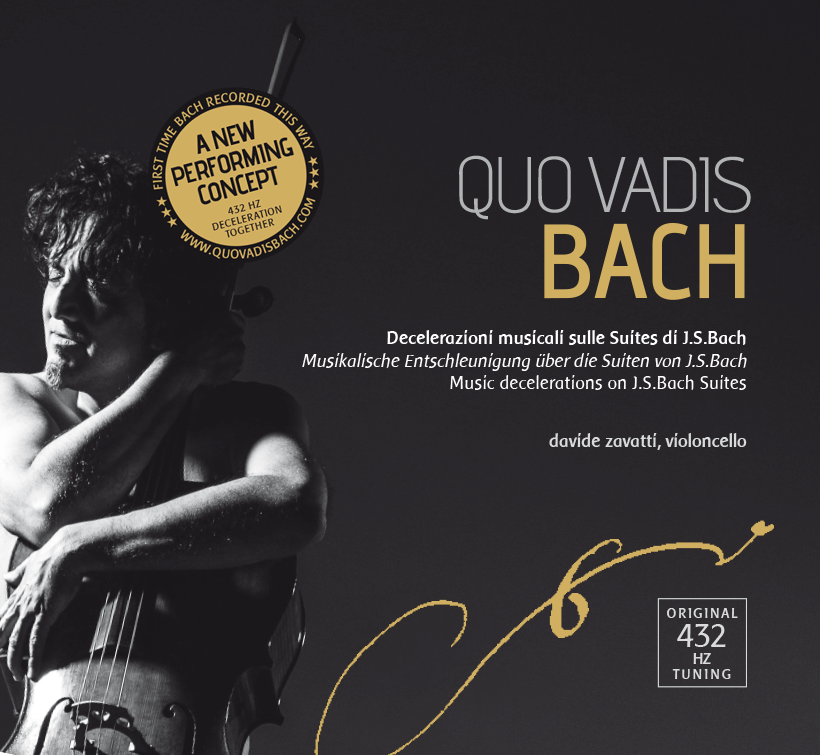
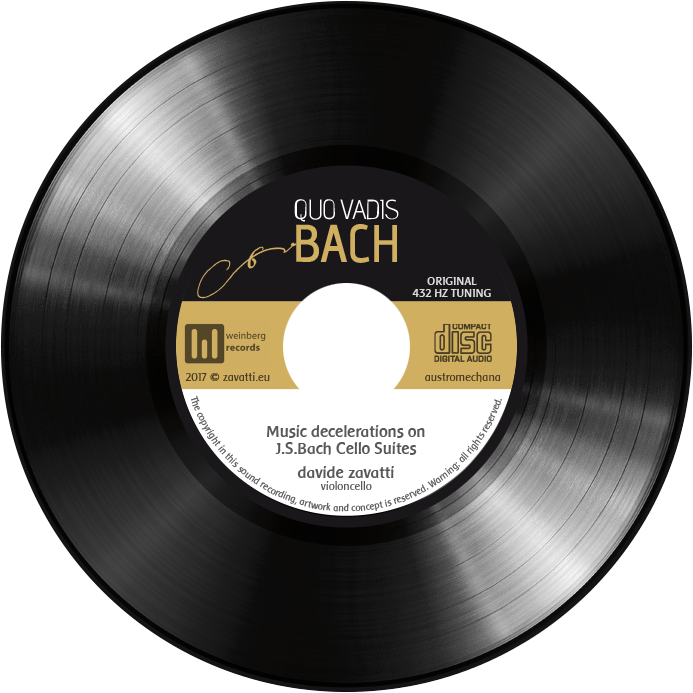
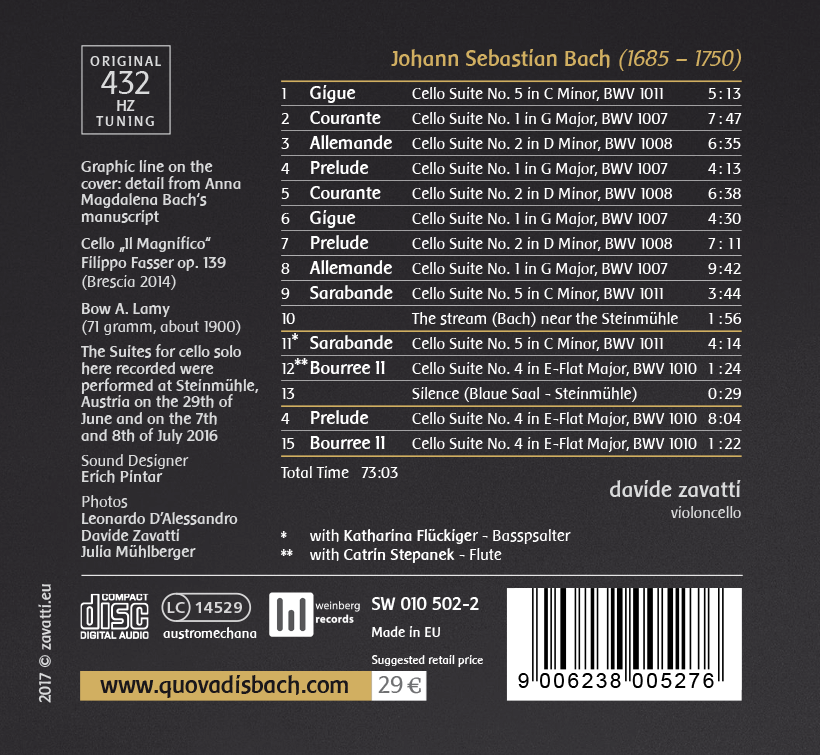
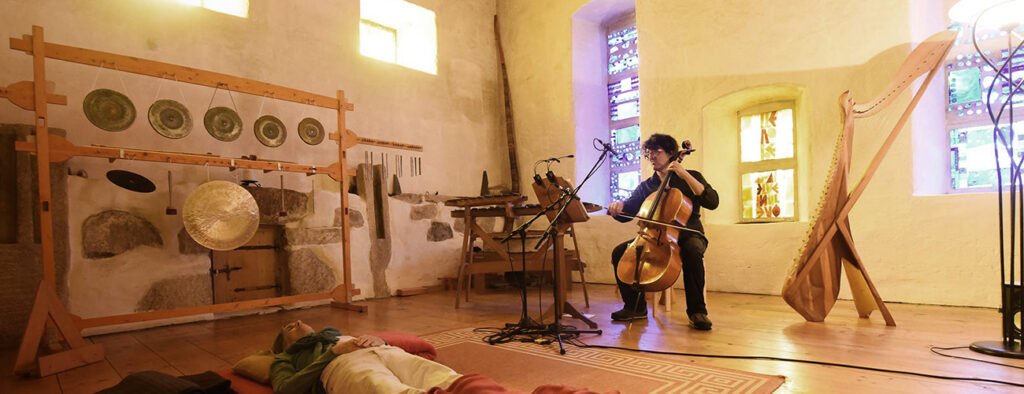
A new performing concept!
432 HZ
It’s probably one of the first times, somebody recording the Cello Suites tuning his cello at 432 Hz pitch. You could read a lot about good reasons to play at 432 Hz, and I don’t want to make a list of them. I just would like to say, I believe 432hz is the keynote of our Earth. It could have profound positive effects on consciousness and also on the cellular level of our bodies. This frequency is often used in meditation, as it promotes peace & relaxation within the body. By retuning musical instruments and using concert pitch at A=432hz instead of A=440Hz, you can feel the difference of connecting awareness to natural resonance. The advantages of this pitch have also been discovered and used in the field of energy healing, among others by former NASA scientist and energy healing pioneer Dr. Barbara Brennan. It might be that you are missing the brilliance and the „sensual“ sound of a higher pitch. Anyway, my cello is playing all the time at 432 Hz. And it seems is enjoying this…
DECELERATION
It’s probably the first time, somebody recording the Cello Suites with a decelerations concept. You might find experiment to slow down existing records, and with computer scaled down. But slow motion is not deceleration! Slow motion is a technical brake. With deceleration you can discover a timeless beauty, alien to technical and mechanical concerns. We absolutely need this timeless beauty, as we are accustomed to systematizing and approving everything; the manuscript of Anna Magdalena is a priceless gift if you make the effort to delve into it. And so, inspired by Albert Schweitzer, in order for the graphic representation to not turn into chaos for the listener, it is vital to not play in slow motion, but decelerated.
TOGETHER
It’s probably the first time, somebody recording the Cello Suites in this way. Anyone who tries to play the Suites with a person lying in front of them, and with the intent to accompany him/her in meditation and recollection through music will be forced, while playing, to smooth the rough edges of his ego, just as a stream (Bach in German!) smoothes stones until they become round, and finally sand. Playing softly does not mean playing quietly, but on tiptoe, with respect and while listening to the breath of the person in front of you.
